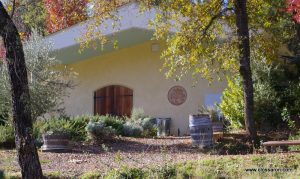 It all started with a half acre of Cabernet Sauvignon, planted in the “wrong” place. Early in 1995, my wife Saron and I were asked by our friend Leonard if we wanted to take over his small (0.5 acre) vineyard and make some wine for ourselves… By then, I suspected that the reason his home-made Cabernet-Merlot blend tended to fall firmly on the leaner and meaner side, had more to do with the unusually cool microclimate in which he planted his vines than with the very humble way he was making them in the tiny, rustic stone cellar he built with his own hands. He gave his blessing to our idea of grafting the vines over to Pinot Noir, a grape variety known for it affinity to such conditions, and Saron proceeded to graft these 400 vines to Pinot; we also doubled the vineyard density by “own-rooting” a Pinot vine between every two grafted ones. This is how our “Old Block” came to be. Three years later we bought this piece of land and Clos Saron was born.
It all started with a half acre of Cabernet Sauvignon, planted in the “wrong” place. Early in 1995, my wife Saron and I were asked by our friend Leonard if we wanted to take over his small (0.5 acre) vineyard and make some wine for ourselves… By then, I suspected that the reason his home-made Cabernet-Merlot blend tended to fall firmly on the leaner and meaner side, had more to do with the unusually cool microclimate in which he planted his vines than with the very humble way he was making them in the tiny, rustic stone cellar he built with his own hands. He gave his blessing to our idea of grafting the vines over to Pinot Noir, a grape variety known for it affinity to such conditions, and Saron proceeded to graft these 400 vines to Pinot; we also doubled the vineyard density by “own-rooting” a Pinot vine between every two grafted ones. This is how our “Old Block” came to be. Three years later we bought this piece of land and Clos Saron was born.
 The Sierra Nevada Foothills are certainly not the first to spring to mind when thinking about Pinot Noir in California, and yet our “Home Vineyard” has proven to be a remarkable, if unlikely, microclimate and soil combination for the production of a distinctive, expressive rendition of this variety. By now, the Home Vineyard – located in Oregon House, California (Yuba County) – is 2.5 acres in size, comprising forty five hundred own-rooted Pinot Noir vines. It is planted on a gentle, well-drained, north-east facing slope at 1500-1600ft altitude, in yellowish clay-loam topsoil on fractured volcanic rock subsoil, sprinkled with fragments of quartz. The virgin soil is pure, uncontaminated, alive with microorganisms and earthworms.
The Sierra Nevada Foothills are certainly not the first to spring to mind when thinking about Pinot Noir in California, and yet our “Home Vineyard” has proven to be a remarkable, if unlikely, microclimate and soil combination for the production of a distinctive, expressive rendition of this variety. By now, the Home Vineyard – located in Oregon House, California (Yuba County) – is 2.5 acres in size, comprising forty five hundred own-rooted Pinot Noir vines. It is planted on a gentle, well-drained, north-east facing slope at 1500-1600ft altitude, in yellowish clay-loam topsoil on fractured volcanic rock subsoil, sprinkled with fragments of quartz. The virgin soil is pure, uncontaminated, alive with microorganisms and earthworms.
Very recently, we have learned that our immediate region is geologically located on a very localized, small section of the Sierra Foothills, known as the “Smartville Complex“. While most of the foothills’ soils are granitic in origin and date back about 15-20 million yeas, this block is sub-oceanic, volcanic in origin, dating back 160 million years. This may begin to explain the distinctive character of our local wines, their unusual aging potential, and structural balance.
 In addition to Pinot Noir, we produce a number of other wines from purchased fruit, all made with the same overriding goal, to express as purely and distinctively as possible the character of the vineyard and grape variet(y/ies). That is the reason why we farm and make wine the way we do: chemical-free and as simply as possible. The more “advanced”, elaborate, and complicated the “wine making” process, the further away it takes the wine from its place of origin. In other words, we apply a “no winemaking” approach to our wine production.
In addition to Pinot Noir, we produce a number of other wines from purchased fruit, all made with the same overriding goal, to express as purely and distinctively as possible the character of the vineyard and grape variet(y/ies). That is the reason why we farm and make wine the way we do: chemical-free and as simply as possible. The more “advanced”, elaborate, and complicated the “wine making” process, the further away it takes the wine from its place of origin. In other words, we apply a “no winemaking” approach to our wine production.